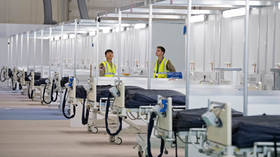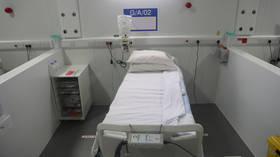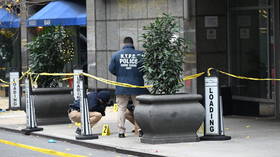Heroic failure: Why did the NHS keep building NINE Covid-19 emergency hospitals even when it was clear there was no need for them?

The Nightingale Hospital in London is being mothballed after treating fewer than 60 patients, and the others around the country are likely to follow suit. It’s all been a typically badly planned, costly cock-up.
It was announced on Monday that the Nightingale Hospital in London is to stop admitting new patients, probably from next week. In truth, patients have been thin on the ground from the start. Despite the claims of NHS bosses and politicians, the whole exercise has been an heroic failure – and a misguided waste of money.
Also on rt.com Useless & invasive? UK’s Covid-19 contact tracing app gets bad reviews after reportedly failing all performance testsThe hospital was announced with great fanfare by the secretary of state for health, Matt Hancock, on March 24. The field hospital, housed at the ExCeL London exhibition centre, was planned to have 500 beds, with the capacity for 4,000-5,000 beds across its two wards if necessary. Working with the British Armed Forces and architects BDP, the hospital was formally opened on April 3 and accepted its first patients on April 7. Everyone seemed to agree it was an astonishing logistical feat.
However, it soon became apparent that the hospital wasn't really needed. Before the UK epidemic took off, London had around 770 intensive care beds across all its hospitals. This increased by the Easter weekend to 1,555, with around 80 percent of them occupied. Wards in other hospitals had been cleared of other patients, so there was plenty of capacity for those suffering from Covid-19.
While there were plenty of beds and ventilators at the Nightingale, there never seemed to be enough staff. Other hospitals seemed unwilling to release experienced staff, especially as they were coping with the demand. The Nightingale was incapable of taking the most frail patients – it could only take the relatively young and fit.
Moreover, transferring patients to the hospital required ambulance staff experienced in transferring critically ill patients – and they were already in high demand. As time went on, it became clear that ventilation of patients was often not desirable and that Covid-19 patients needed other kinds of care too, like kidney dialysis, which the Nightingale couldn't provide.
While there have been conflicting reports, the hospital seems never to have had more than 60 patients, and most of the time far fewer. A week before the closure was announced, a spokesperson was already having to justify the exercise: “The whole point of the London Nightingale has been to build extra capacity to help local hospitals ensure all those who need care can get it. It will be a mark of success if it continues not to operate at full capacity.”
That is a triumph of understatement; far from not operating at ‘full capacity’, the hospital barely had patients at all.
The hospital was quickly turning into an embarrassment. The Daily Mail reported on April 25 that the empty wards had “shattered morale.” The first patient to leave the hospital was applauded by staff – a PR coup for management. But the Mail claims the patient was actually very ill and was simply being transferred to another hospital for treatment.
There has been talk of using the Nightingale to take recovering Covid-19 patients, leaving other hospitals to return to focusing on non-Covid patients, but the closure announcement suggests even this isn't needed.
Also on rt.com Mishandling of Black Death 640 years ago led to the Peasants’ Revolt. It’s time we modern-day peasants rebelled over Covid-19Still, a one-off experiment in providing extra capacity in the hardest-hit part of the UK seems acceptable. What is bizarre is that, without waiting to assess the effectiveness of the Nightingale in London, others were springing up across the country: Birmingham, Bristol, Exeter, Harrogate, Manchester and Washington. NHS Scotland opened the Louisa Jordan Hospital in Glasgow along similar lines with 1,000 beds, and the Dragon's Heart Hospital was opened in Cardiff.
However, the ambition of these hospitals seems much reduced. Birmingham and Manchester are for “step down” care only – that is, for recovering patients. Even so, the Birmingham hospital has never had any patients at all. The Nightingale North East at Washington, near Sunderland, may never open, nor may the hospital in Exeter.
Repurposing the hospitals is probably a non-starter. As the clinical director of NHS Scotland, Professor Jason Leitch, put it in a public Q&A on Monday: “We have to remember what the Louisa Jordan Hospital is. It is an emergency hospital built inside a conference centre… It has no operating theatres and it's not the kind of environment you would want to be in for long. It may be that we start to think of alternative uses for it, but we are not going to do that lightly. I wonder if we might use it for outpatient care. Overnight care, I'm not certain that is something I would feel happy recommending unless it was absolutely necessary.”
Perhaps it seems churlish to be critical of these field hospitals. Back in March, it was far from clear how many patients would need intensive care. Images of health service overload in Italy clearly spooked politicians and health officials. However, there were problems that could have been recognised at the time.
First, the modellers from Imperial College London, led by Professor Neil Ferguson, assumed that almost a third of infected over-80s would be hospitalised with coronavirus and over 70 percent of them would need critical care. But as one intensive care doctor told the Telegraph last weekend: “There is no disease on the planet that would mean we would intubate and ventilate 70 percent of over 80 year olds, because they don’t survive – they’re too frail.” It seems no-one asked intensive care staff to check these assumptions.
Second, there seems to have been far too little flexibility of thinking on the part of politicians and health officials. Not only do Covid-19 patients need a wider range of support than just ventilators, but it has become apparent that putting patients on ventilators is in most cases either useless or positively dangerous. So an exhibition hall full of beds and ventilators, but no easy access to other elements of critical care, is not much help. Even for “step down” care, it is hardly a pleasant environment to recover in.
Third, officials and ministers didn't seem to be paying attention to the actual data emerging on the epidemic. Researchers at Oxford's Centre for Evidence-Based Medicine have been arguing for some time that infections peaked on March 16 and deaths peaked on April 8. Either the disease is already in decline naturally or the lockdown has been far more successful than expected. Hospitalisations have been falling for weeks. Yet still the work to create these hospitals ploughed on.
In short, ministers and officials over-reacted to events, then were incapable of changing course when it was apparent that their original plans were unnecessary. For a health service that is supposedly always short of resources, this seems an incredible waste.
If you like this story, share it with a friend!
The statements, views and opinions expressed in this column are solely those of the author and do not necessarily represent those of RT.















